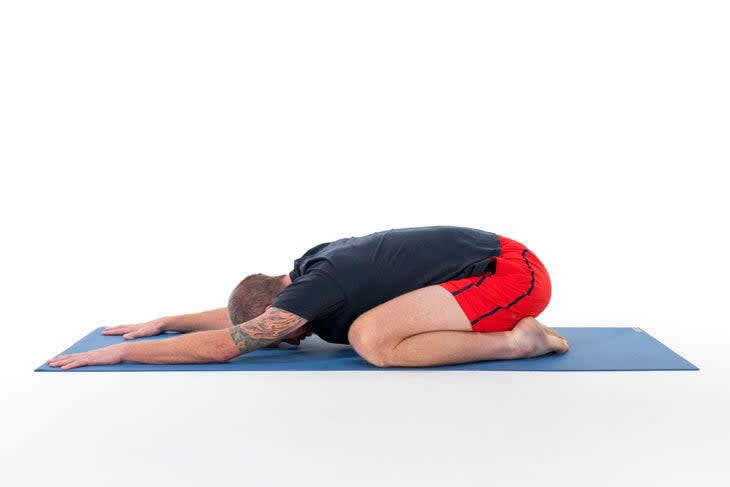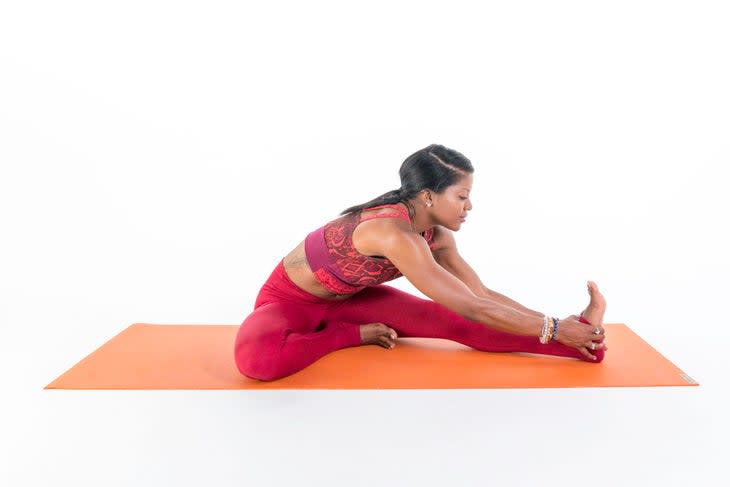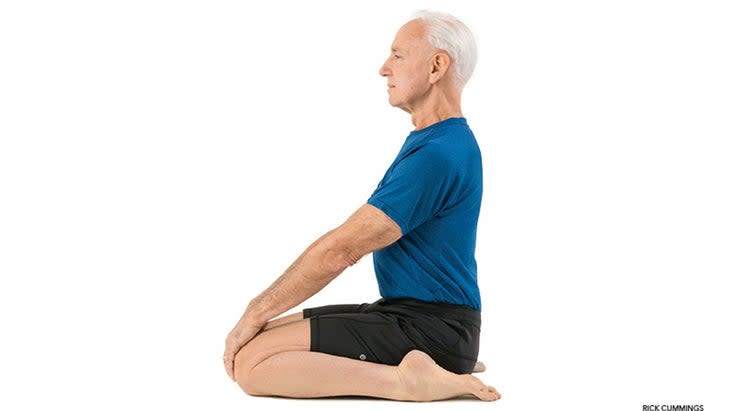6 Yoga Poses for High Blood Pressure
High blood pressure--otherwise known as hypertension--is among the most common health conditions in the U.S. According to the Centers for Disease Control & Prevention, nearly half of adults have hypertension, yet many people don't even know they have it.
But just because high blood pressure is so common doesn't mean you should ignore it. Hypertension can put people at risk for serious health conditions, such as heart attacks or strokes. Lifestyle changes top the list of steps you can take to improve or prevent hypertension--and research shows that yoga can play a crucial role in lowering high blood pressure.
What is blood pressure, exactly? And what causes hypertension?
Blood pressure is the amount of force your heart exerts against the walls of your blood vessels. If your heart is healthy and your blood vessels are flexible, not a lot of force is required to circulate blood throughout your body.
However, if your heart is stressed or your blood vessels become rigid and inflexible, the heart must pump harder to circulate blood. The result is more strain on the heart and damage to the walls of your blood vessels, increasing your risk of heart attack, stroke, and other dangerous health conditions.
The exact cause of high blood pressure varies from person to person. Risk factors include:
Family history
Age: Blood vessels naturally become less elastic as we get older, increasing the risk of high blood pressure.
Gender: Men are more likely to develop high blood pressure in middle age, while women are more likely to develop high blood pressure as they get older.
Race: African Americans or Black Americans are at higher risk of hypertension.
Chronic kidney disease (CHD)
Unhealthy lifestyle habits such as:
Lack of physical activity
Poor diet
Smoking
Excessive alcohol intake
Being overweight
Stress
While you can't change your family history, you can make better lifestyle choices that keep your blood pressure in a healthy range. That's where yoga comes in.
How yoga can help your blood pressure
Numerous studies have shown the benefits that yoga can have on hypertension.
A recent study tested the use of yoga three times a week for people being treated for high blood pressure. The results showed those who practiced yoga experienced a significant reduction in their blood pressure compared to those who did not. Another study found the effect of yoga on high blood pressure is even more significant when breathwork and meditation are part of the practice.
A 2020 study examined the impact of a one-hour yoga class on the flexibility of the arteries. The more flexible your blood vessels, the less pressure required for blood flow and the lower your risk of hypertension. Researchers found people had more flexible arteries after practicing yoga.
If you have high blood pressure, talk to your doctor before practicing yoga. In some cases, certain yoga poses should be avoided, including inversions. Always follow your doctors' guidance and pay attention to how your blood pressure responds to your yoga practice.
6 poses for high blood pressure
Balasana (Child's Pose)
Why it helps with high blood pressure: Child's Pose provides an opportunity for calm and relaxation. It also prepares the hips and spine for movement by providing openness and length.
How to practice: From hands and knees, bring your big toes to touch and widen your legs slightly wider than hip-distance. Exhale and sit your hips back toward your heels, keeping your arms extended forward. Your outer ribs should rest comfortably on your inner thighs. Arms can remain forward or be moved to rest alongside your body. Lengthen your sacrum toward your heels as you elongate your spine. Tuck your chin in slightly to lengthen the back of your neck. Rest your forehead on the floor. With each inhale, feel your ribcage expand out to your thighs, and with each exhale, let your body relax toward the floor. Stay here for 1-3 minutes.
Paschimottanasana (Seated Forward Bend)
Why it helps with high blood pressure: Seated forward bends can be very calming. For this pose, have several pillows available to stack on your thighs and rest your forehead on if you like.
How to practice: Begin in Dandasana (Staff Pose), sitting on the floor with your legs out in front of you. Sit up straight, pressing your heels away from your body and your fingertips into the floor beside your hips. Inhale. On an exhale, bend forward from your hips, keeping your torso long and your spine straight. Walk your hands along the outside of your legs, reaching as far as they can go while maintaining the length in your spine. If you can reach them, hold the sides of your feet with your hands. With each inhalation, lift and lengthen your front torso just slightly; with each exhalation, release a little more fully into the forward bend. Stay here for 1-3 minutes.
Baddha Konasana (Bound Angle Pose)
Why it helps with high blood pressure: This pose is a delicious hip opener, but it also increases your body’s circulation.
How to practice: Take a seat on the ground with your legs straight. Bend your knees and bring the soles of your feet together allowing your knees to fall open. Your hands can rest on the floor behind you to provide support for your spine, or gently hold your feet. With an inhale, lengthen the spine, reaching up through the crown of your head. Slide your shoulder blades down and lengthen the back of your neck. Stay for 3-5 breaths, feeling each inhale expand the ribs outward.
Janu Sirsasana (Head-to-Knee Pose)
Why it helps with high blood pressure: Talk about soothing. This pose not only stretches those super-tight muscles in your back and legs, but it also calms the mind and eases anxiety and fatigue.
How to practice: From a seated position, extend your right leg straight and bend your left knee, placing the bottom of your left foot against your right inner thigh. Sit up on a block or folded blanket if your hamstrings or lower back feel tight. Square your hips forward, and with an inhale reach your arms overhead to lengthen your spine. On your exhale forward fold over your right leg allowing your hands to lightly hold your right foot or rest on the floor wherever they comfortably land. Press your right heel gently into the floor as you lengthen your chest over the right leg. Keep the back of your neck long and your shoulders relaxed away from the ears. Focus on long, smooth inhales and exhales. Stay for 3-5 breaths and then switch sides.
Virasana (Hero Pose) with extended exhale breathing
Why it helps with high blood pressure: Yoga practices that include breath work have been shown to provide the most benefit to your blood pressure. Lengthening your exhale activates your calming nervous system, relieving stress and lowering your blood pressure.
How to practice: Kneel with your legs hip-width distance apart and the tops of your feet pointing straight behind you. Have a block or folded blanket available to sit on for comfort. Sit back either on the floor between your feet or on a block placed between your feet. Sit tall, reaching the crown of your head up and lengthening the back of your neck. If your feel any knee discomfort, sit higher on additional blocks or blankets. Rest your hands comfortably on your thighs and allow your eyes to close. Bring your attention to your breath. Notice the length of your inhale and exhale.
After a few normal breaths, begin to lengthen your exhale to be a few counts longer than your inhale. For example, inhale to a count of 4 and exhale to a count of 6. Find the count that works for you. At all times, your breathing should be relaxed and comfortable, never strained. Stay with the extended exhale breathing for 3-5 minutes, or as long as is comfortable.
Savasana (Corpse Pose)
Why it helps with high blood pressure: Many people with high blood pressure are so used to a fast-paced, high-pressure life that they may have forgotten how to slow down and relax. The final resting pose in a yoga class, Savasana, is especially important to teach you how to be still and at peace. Don't skip it!
How to practice: Lie down on your back with your legs straight and your arms resting alongside your body. Tuck your shoulder blades underneath you and draw your chin in slightly. Allow your legs and feet to relax and turn out. Feel the entire length of your spine relaxing toward the floor. A good Savasana should be at least 10 minutes, but 20 minutes is even better because it allows more time for your body and mind to truly relax. Savasana takes practice, so work your way up to longer sessions in the pose. Think of it as relaxation training. Your blood pressure will thank you!
For exclusive access to all of our fitness, gear, adventure, and travel stories, plus discounts on trips, events, and gear, sign up for Outside+ today.







